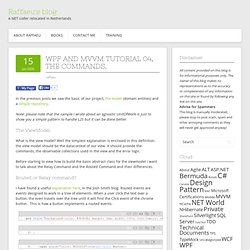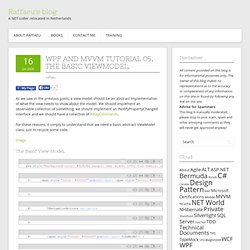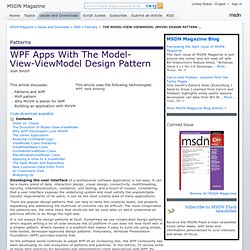

WPF and MVVM tutorial 04, The Commands. In the previous posts we saw the basic of our project, the model (domain entities) and a simple repository.

Note: please note that the sample I wrote about an agnostic UnitOfWork is just to show you a simple pattern to handle L2S but it can be done better. The ViewModel. WPF and MVVM tutorial 05, The basic ViewModel. As we saw in the previous posts, a view model should be an abstract implementation of what the view needs to show about the model.

We should implement an observable collection of something, we should implement an INotifyPropertyChanged interface and we should have a collection of RelayCommands. For these reasons, it simply to understand that we need a basic abstract ViewModel class, just to recycle some code. The Basic View Model. <pre style="background-color: #fbfbfb; margin: 0em; width: 100%; font-family: consolas,'Courier New',courier,monospace; font-size: 13px"> 1: <span style="color: #0000ff">namespace</span> MVVM.ViewModel { 2: <span style="color: #0000ff">public</span><span style="color: #0000ff">abstract</span><span style="color: #0000ff">class</span> ViewModel:INotifyPropertyChanged,IDisposable {
WPF and MVVM tutorial 06, start up form. Today we are going to create the start-up form of our project and use the first ViewModel to run the application logic. The result we want to obtain will be: The View Model for the Startup form. WPF and MVVM tutorial 07, the List search. Ok, starting from this post we are going to do something really interesting.

In this episode we need to create a simple List windows, but as you will see the logic will not be so different then a one-to-many form. This will be the final result: The ViewModel for the List Window. First of all we need to create the view model. Jason Dolinger on Model-View-ViewModel » Lab49 Blog. A while back, Jason Dolinger, a consultant here at Lab49, gave us a presentation on design in WPF with the Model-View-ViewModel pattern and the Unity dependency injection framework.

Jason started with an application that one would write in a “traditional” way, with button clicks handled by event-handlers in the code-behind that then updated other parts of the UI. Using WPF data-binding, Commands, and Unity, he transformed it, piece by piece, in a much more manageable, encapsulated, readable, and testable M-V-VM design. It was awesome. It was so awesome, in fact, that after the presentation Jason recorded the demo for all to see here. Check it out. UPDATE: I thought I should mention that while Jason’s presentation is geared towards WPF, the patterns he describes are very applicable for Silverlight as well. 1) Jason creates ViewModels that are DependencyObjects. 3) Silverlight does not support bindings for Commands out of the box. Using MVVM with Menus in WPF. Menus and MVVM (2) MVVM for Tarded Folks Like Me. MVVM has been a trending topic lately.
And why shouldn’t it be? People want to build great WPF/SL applications and want guidance on how to build them using the framework’s strengths. If you are anything like me, you started your WPF/SL career, learning the framework classes and hierarchy. You learned XAML, triggers, storyboards and animations. You even hobbled together something that looked mind blowing, but the code was a monstrosity. I’m going to go out on a limb and make a wild assumption. Beginner’s MVVM Challenge #1 |or| Takin’ You Down to MVVM Town So we want to begin our journey into MVVM town by way of Bindingopolis. A model is a class that has your data. Class Model public string Name { get; set; } public string Address { get; set; } A view is, for the sake of explanation, is a UserControl. /// Interaction logic for View.xaml. Model-View-ViewModel (MVVM) Explained.
The purpose of this post is to provide an introduction to the Model-View-ViewModel (MVVM) pattern.

While I've participated in lots of discussions online about MVVM, it occurred to me that beginners who are learning the pattern have very little to go on and a lot of conflicting resources to wade through in order to try to implement it in their own code. I am not trying to introduce dogma but wanted to pull together key concepts in a single post to make it easy and straightforward to understand the value of the pattern and how it can be implemented. MVVM is really far simpler than people make it out to be. Click here to read the Spanish version (Leer en español) MVVM Links\Info. Open File Dialog MVVM. WPF OpenFileDialog with the MVVM pattern? THE MODEL-VIEW-VIEWMODEL (MVVM) DESIGN PATTERN FOR WPF. Patterns WPF Apps With The Model-View-ViewModel Design Pattern Josh Smith Developing the user interface of a professional software application is not easy.

It can be a murky blend of data, interaction design, visual design, connectivity, multithreading, security, internationalization, validation, unit testing, and a touch of voodoo. Considering that a user interface exposes the underlying system and must satisfy the unpredictable stylistic requirements of its users, it can be the most volatile area of many applications. There are popular design patterns that can help to tame this unwieldy beast, but properly separating and addressing the multitude of concerns can be difficult. It is not always the design patterns at fault. As the software world continues to adopt WPF at an increasing rate, the WPF community has been developing its own ecosystem of patterns and practices. Order vs. It is unnecessary and counterproductive to use design patterns in a simple "Hello, World! " Figure 1 Workspaces. MVVM with Type-Safe INotifyPropertyChanged.